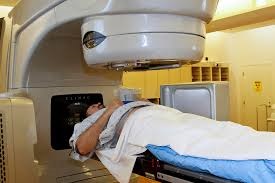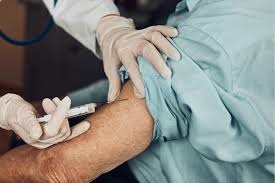TREATMENT OPTIONS FOR PROSTATE CANCER

Prostate cancer, a common malignancy among men, requires a tailored treatment approach based on various factors, including the stage of cancer and the patient’s overall health. In this detailed guide, we explore the primary treatment options available for this cancer, including surgery, radiation therapy, hormonal therapy, and chemotherapy. We will also discuss how treatment choices are made and highlight the importance of palliative care for patients with advanced-stage of the above mentioned cancer.
UNDERSTANDING PROSTATE CANCER TREATMENTS
1. Surgery:

Surgery is often considered a primary treatment option for prostate cancer, particularly when the cancer is localized. The main types of surgery include:
a. Radical Prostatectomy
Radical prostatectomy involves the complete removal of the prostate gland along with some surrounding tissue, including the seminal vesicles and, in some cases, nearby lymph nodes. This procedure is typically recommended for men with localized prostate cancer who are in good health and have a life expectancy of at least 10 years [1].
Advantages of Radical Prostatectomy:
- Potential for Cure: For many men with localized prostate cancer, radical prostatectomy offers a high chance of curing the disease [2]. The goal is to remove all cancerous tissue and reduce the likelihood of recurrence.
- Long-Term Control: Studies have shown that radical prostatectomy can offer long-term control of this cancer, especially when the cancer has not spread beyond the prostate [3].
Limitations of Radical Prostatectomy:
- Side Effects: This surgery can lead to side effects such as urinary incontinence and erectile dysfunction. Advances in surgical techniques, including nerve-sparing approaches, have aimed to minimize these effects, but they can still be significant for some patients [4].
- Recovery Time: The recovery period after a radical prostatectomy can be extensive, involving several weeks of downtime and rehabilitation [5].
2. Radiation Therapy:

Radiation therapy uses high-energy rays to target and destroy cancer cells. There are two main types of radiation therapy used to treat prostate cancer:
a. External Beam Radiation Therapy (EBRT)
External beam radiation therapy involves directing radiation beams from outside the body to the prostate gland. The procedure is typically performed on an outpatient basis and requires several sessions over a few weeks [6].
Advantages of EBRT:
- Non-Invasive: EBRT is a non-invasive treatment option that does not require surgery [7]. This can be particularly beneficial for patients who are not candidates for surgical procedures.
- Effective for Localized Cancer: EBRT is effective in treating localized prostate cancer and can be used as a primary treatment or after surgery if cancer persists [8].
Limitations of EBRT:
- Side Effects: Potential side effects include urinary and bowel issues, such as discomfort or frequency of urination and diarrhea. These effects are often temporary but can be bothersome for some patients [9].
- Treatment Duration: The treatment course for EBRT can span several weeks, which may be challenging for patients with busy schedules or other health issues [10].
b. Brachytherapy
Brachytherapy, also known as internal radiation therapy, involves implanting radioactive seeds directly into the prostate gland. These seeds emit radiation over a period of time, targeting cancer cells while minimizing damage to surrounding tissues [11].
Advantages of Brachytherapy:
- Localized Treatment: Brachytherapy provides a highly localized treatment option with minimal exposure to surrounding tissues [12]. This can reduce the risk of side effects compared to EBRT.
- Shorter Treatment Duration: The procedure is typically completed in one or two sessions, which is more convenient compared to the extended duration of EBRT [13].
Limitations of Brachytherapy:
- Initial Discomfort: Patients may experience discomfort or swelling in the area where the seeds are implanted. This is usually temporary but can be uncomfortable [14].
- Not Suitable for All Patients: Brachytherapy is often used for early-stage prostate cancer and may not be appropriate for more advanced cases or larger prostates [15].
3. Hormonal Therapy:

Hormonal therapy, or androgen deprivation therapy (ADT), works by reducing the levels of male hormones (androgens) like testosterone that fuel the growth of prostate cancer cells. This treatment is commonly used for advanced prostate cancer or when the cancer has spread beyond the prostate [16].
a. Luteinizing Hormone-Releasing Hormone (LHRH) Agonists
LHRH agonists reduce testosterone levels by signaling the pituitary gland to decrease the production of hormones that stimulate testosterone production [17]. Examples include leuprolide and goserelin.
Advantages of LHRH Agonists:
- Effective for Advanced Cancer: LHRH agonists are effective in controlling cancer growth and symptoms in patients with advanced or metastatic prostate cancer [18].
- Non-Surgical: These medications provide a non-surgical approach to managing prostate cancer and can be administered via injections or implants [19].
Limitations of LHRH Agonists:
- Side Effects: Common side effects include hot flashes, reduced libido, and potential bone density loss [20]. These effects can impact the patient’s quality of life.
- Requires Ongoing Treatment: Hormonal therapy is often a long-term treatment, requiring continuous management and monitoring [21].
b. Anti-Androgens
Anti-androgens, such as bicalutamide, work by blocking the action of testosterone on cancer cells. These medications are often used in combination with LHRH agonists to enhance treatment efficacy [22].
Advantages of Anti-Androgens:
- Complementary Therapy: Anti-androgens can be used in combination with other hormonal therapies to provide a more comprehensive approach to managing this cancer [23].
- Targeted Action: These drugs specifically target the cancer cells’ response to testosterone, potentially reducing some side effects associated with other hormonal therapies [24].
Limitations of Anti-Androgens:
- Potential Resistance: Over time, some cancers may become resistant to anti-androgen therapy, necessitating changes in treatment strategies [25].
- Side Effects: Similar to other hormonal therapies, anti-androgens can cause side effects such as fatigue and gastrointestinal issues [26].
4. Chemotherapy:

Chemotherapy uses powerful drugs to kill rapidly growing cancer cells. It is typically used for prostate cancer that has spread beyond the prostate gland and does not respond well to hormonal therapies [27]. Common chemotherapy drugs include docetaxel and cabazitaxel.
Advantages of Chemotherapy:
- Effective for Metastatic Cancer: Chemotherapy can be effective in treating this cancer that has metastasized to other parts of the body [28]. It helps in managing symptoms and slowing cancer progression.
- Combination Therapy: Chemotherapy can be used in conjunction with other treatments, such as hormonal therapy, to provide a multi-faceted approach to cancer management [29].
Limitations of Chemotherapy:
- Side Effects: Chemotherapy is associated with side effects such as nausea, hair loss, and increased susceptibility to infections [30]. These side effects can significantly impact a patient’s quality of life.
- Not Always Curative: While chemotherapy can help manage symptoms and extend survival, it is not always curative, especially in advanced stages [31].
CHOOSING THE RIGHT TREATMENT FOR PROSTATE CANCER

FACTORS INFLUENCING TREATMENT CHOICE OF PROSTATE CANCER PATIENTS:

The choice of treatment for the above mentioned cancer depends on several factors, including:
- Stage of Cancer: The stage of prostate cancer is crucial in determining the appropriate treatment. For localized cancer, surgery or radiation therapy may be recommended, while advanced cancer might require hormonal therapy or chemotherapy [32].
- Patient’s Overall Health: A patient’s overall health and pre-existing conditions play a significant role in treatment decisions. For example, patients with other health issues may not be suitable candidates for surgery or chemotherapy [33].
- Personal Preferences: Patient preferences and quality of life considerations are also important. Discussions with healthcare providers help in choosing a treatment that aligns with the patient’s values and lifestyle [34].
THE IMPORTANCE OF PALLIATIVE CARE FOR PROSTATE CANCER PATIENTS

For patients with advanced-stage of the discussed cancer, palliative care plays a vital role. Palliative care focuses on relieving symptoms and improving quality of life, rather than curing the disease [35].
Benefits of Palliative Care:
- Symptom Management: Palliative care helps manage symptoms such as pain, nausea, and fatigue, providing comfort and enhancing the patient’s well-being [36].
- Emotional and Psychological Support: This care also addresses emotional and psychological needs, offering counseling and support to both patients and their families [37].
- Coordination of Care: Palliative care teams work closely with other healthcare providers to ensure comprehensive and coordinated care, helping to navigate complex treatment options [38].
CONCLUSION.
In conclusion, The treatment of this cancer involves a range of options, including surgery, radiation therapy, hormonal therapy, and chemotherapy. The choice of treatment depends on various factors, including the stage of cancer, the patient’s overall health, and personal preferences. Regular consultations with healthcare providers ensure that the treatment plan is tailored to the individual’s needs.
Furthermore, for patients with advanced-stage of the said cancer, palliative care is essential in managing symptoms and improving quality of life. By understanding and utilizing the available treatment options, patients can make informed decisions and manage their cancer effectively.
REFERENCES:
- American Cancer Society. (2023). Prostate Cancer Treatment. Retrieved from American Cancer Society
- Mayo Clinic. (2023). Radical Prostatectomy. Retrieved from Mayo Clinic
- National Cancer Institute. (2023). Prostate Cancer Treatment. Retrieved from National Cancer Institute
- Cleveland Clinic. (2023). Side Effects of Prostate Cancer Surgery. Retrieved from Cleveland Clinic
- Urology Care Foundation. (2023). Recovery After Prostate Cancer Surgery. Retrieved from Urology Care Foundation
- Cancer Research UK. (2023). External Beam Radiotherapy. Retrieved from Cancer Research UK
- American Urological Association. (2023). External Beam Radiation Therapy for Prostate Cancer. Retrieved from AUA
- Prostate Cancer Foundation. (2023). Effectiveness of External Beam Radiation Therapy. Retrieved from Prostate Cancer Foundation
- Journal of Clinical Oncology. (2023). Side Effects of Radiation Therapy. Retrieved from Journal of Clinical Oncology
- National Comprehensive Cancer Network. (2023). Radiation Therapy for Prostate Cancer. Retrieved from NCCN
- American Cancer Society. (2023). Brachytherapy for Prostate Cancer. Retrieved from American Cancer Society
- Mayo Clinic. (2023). Advantages of Brachytherapy. Retrieved from Mayo Clinic
- Prostate Cancer Foundation. (2023). Brachytherapy for Early-Stage Prostate Cancer. Retrieved from Prostate Cancer Foundation
- Cleveland Clinic. (2023). Discomfort from Brachytherapy. Retrieved from Cleveland Clinic
- National Cancer Institute. (2023). Suitability of Brachytherapy. Retrieved from National Cancer Institute
- American Cancer Society. (2023). Hormonal Therapy for Prostate Cancer. Retrieved from American Cancer Society
- National Comprehensive Cancer Network. (2023). LHRH Agonists in Prostate Cancer Treatment. Retrieved from NCCN
- Prostate Cancer Foundation. (2023). Effectiveness of LHRH Agonists. Retrieved from Prostate Cancer Foundation
- Mayo Clinic. (2023). LHRH Agonists for Prostate Cancer. Retrieved from Mayo Clinic
- Cleveland Clinic. (2023). Side Effects of Hormonal Therapy. Retrieved from Cleveland Clinic
- American Urological Association. (2023). Managing Hormonal Therapy. Retrieved from AUA
- National Cancer Institute. (2023). Anti-Androgens for Prostate Cancer. Retrieved from National Cancer Institute
- Prostate Cancer Foundation. (2023). Role of Anti-Androgens. Retrieved from Prostate Cancer Foundation
- American Cancer Society. (2023). Effects of Anti-Androgens. Retrieved from American Cancer Society
- Journal of Clinical Oncology. (2023). Resistance to Anti-Androgen Therapy. Retrieved from Journal of Clinical Oncology
- Cleveland Clinic. (2023). Side Effects of Anti-Androgens. Retrieved from Cleveland Clinic
- National Comprehensive Cancer Network. (2023). Chemotherapy for Prostate Cancer. Retrieved from NCCN
- American Cancer Society. (2023). Chemotherapy for Advanced Prostate Cancer. Retrieved from American Cancer Society
- Prostate Cancer Foundation. (2023). Combining Chemotherapy with Other Treatments. Retrieved from Prostate Cancer Foundation
- Mayo Clinic. (2023). Side Effects of Chemotherapy. Retrieved from Mayo Clinic
- Cleveland Clinic. (2023). Effectiveness of Chemotherapy. Retrieved from Cleveland Clinic
- National Cancer Institute. (2023). Choosing a Prostate Cancer Treatment. Retrieved from National Cancer Institute
- American Cancer Society. (2023). Factors Influencing Prostate Cancer Treatment Decisions. Retrieved from American Cancer Society
- Mayo Clinic. (2023). Patient Preferences in Prostate Cancer Treatment. Retrieved from Mayo Clinic
- Prostate Cancer Foundation. (2023). Palliative Care for Prostate Cancer. Retrieved from Prostate Cancer Foundation
- National Cancer Institute. (2023). Benefits of Palliative Care. Retrieved from National Cancer Institute
- American Cancer Society. (2023). Emotional and Psychological Support in Palliative Care. Retrieved from American Cancer Society
- Cleveland Clinic. (2023). Coordinating Care in Palliative Treatment. Retrieved from Cleveland Clinic